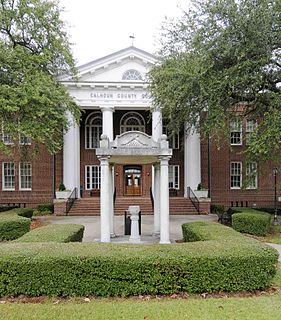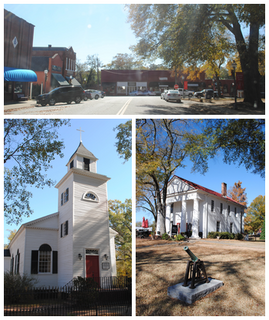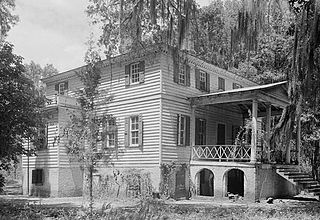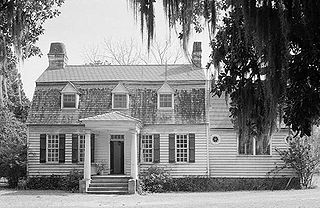
Calhoun County is a county in the U.S. state of South Carolina. As of the 2010 census, its population was 15,175, making it the third-least populous county in the state. Its county seat is St. Matthews.

Pendleton is a town in Anderson County, South Carolina, United States. The population was 2,964 at the 2010 census. It is a sister city of Stornoway in the Outer Hebrides of Scotland.

Clemson is a city in Pickens and Anderson counties in the U.S. state of South Carolina. Clemson is home to Clemson University; in 2015, the Princeton Review cited the town of Clemson as ranking #1 in the United States for "town-and-gown" relations with its resident university. The population of the city was 13,905 at the 2010 census.
Fort Motte was developed first as Mt. Joseph Plantation; it was commandeered in 1780 by the British and fortified as a temporary military outpost in what is now South Carolina during the American Revolutionary War. It was significant for its military use as a depot for their convoys between Camden and Charleston, which they occupied. Located along the Congaree River, it is roughly 90–95 miles from Charleston by 21st-century roadways. The British had fortified the big house and surrounds, and it became known as Fort Motte, after Rebecca Brewton Motte, who had been occupying it with her family. During the Patriot Siege of Fort Motte, the plantation mansion was set on fire. The British surrendered at this site.
The Cherokee Path was the primary route of English and Scots traders from Charleston to Columbia, South Carolina in Colonial America. It was the way they reached Cherokee towns and territories along the upper Keowee River and its tributaries. In its lower section it was known as the Savannah River. They referred to these towns along the Keowee and Tugaloo rivers as the Lower Towns, in contrast to the Middle Towns in Western North Carolina and the Overhill Towns in present-day southeastern Tennessee west of the Appalachian Mountains.

Fort Hill, John C Calhoun House and libraries', is a National Historic Landmark on the Clemson University campus in Clemson, South Carolina, United States. The house is significant as the home of John C. Calhoun, the 7th Vice President of the United States, from 1825 to 1850. It is now a house for museums and libraries.

The Miles Brewton House is a National Historic Landmark residential complex located in Charleston, South Carolina. It is one of the finest examples of a double house in Charleston, designed on principles articulated by Andrea Palladio. Located on two acres, its extensive collection of dependencies makes it one of the most complete Georgian townhouse complexes in America. The house was built ca. 1765-1769 for Miles Brewton, a wealthy slave trader and planter.
Oakland Plantation may refer to:
Oakland is a city in California, United States.

Fairfield Plantation, also known as the Lynch House is a plantation about 5 mi (8 km) east of McClellanville in Charleston County, South Carolina. It is adjacent to the Wedge Plantation and just north of Harrietta Plantation. The plantation house was built around 1730. It is located just off US Highway 17 near the Santee River. It was named to the National Register of Historic Places on September 18, 1975.

The Oakland Plantation House which is also known as Youghall or Youghal Plantation House, was built about 1750 in Charleston County, South Carolina about 7 mi (11 km) east of Mount Pleasant. It is located about 1 mile (1.6 km) south of U.S. Route 17 on Stratton Place. It was named to the National Register of Historic Places on July 13, 1977.
Midway Plantation may refer to:

Rebecca Brewton Motte (1737–1815) was a plantation owner in South Carolina and townhouse owner in its chief city of Charleston. She was known as a patriot in the American Revolution, supplying continental forces with food and supplies for five years. By the end of the war, she had become one of the wealthiest individuals in the state, having inherited property from both her older brother Miles Brewton, who was lost at sea in 1775, and her husband Jacob Motte, who died in 1780.

Oakland Plantation, also known as the Wade Glover House, is a historic plantation home located near Beech Island, Aiken County, South Carolina. It was built in 1824–1826, and is a Carolina I-house with minimal mid-19th century and early-20th century additions and alterations. It has a central hall two-over-two floor plan with gable-end chimneys, one-story gallery on the facade, and shed room on the rear elevation. Also on the property are two contributing outbuildings: a frame one-story gable-end dairy house and a frame one-story gable-end garage.

Midway Plantation is a historic plantation house located near Fort Motte, Calhoun County, South Carolina. The original Midway plantation was built about 1785, although little of this structure remains. The present façade was added about 1859, and is a two-story antebellum frame building with both Greek Revival and Federal influences. The front façade features a pediment and a two-tiered portico with four Tuscan order columns on both levels. The rear wing and porch were added around 1900.

Zante Plantation was a historic plantation house located near Fort Motte, Calhoun County, South Carolina. It was built about 1815, and is a 2+1⁄2-story frame structure with Federal details. It has a stucco-over-brick foundation approximately seven feet high. Both front and rear facades have one-story porches. Several original outbuildings remain on the property. Zante has been the home of several prominent South Carolinians, its history reaching as far back as the late-18th century.

Col. J. A. Banks House is a historic home located at St. Matthews, Calhoun County, South Carolina. It was built about 1893, and remodeled in 1909–1910. It is a two-story, asymmetrical plan dwelling that incorporates both Classical and Victorian elements. The house features two Neo-Classical colossal Corinthian order porticos and gable pediments with Palladian windows. Also on the property are two one-story, weatherboarded contributing outbuildings: a fowl house and a workshop. It was the home of South Carolina State Representative and State Senator Col. J. A. Banks.

David Houser House, also known as Oak Grove, is a historic home located near St. Matthews, Calhoun County, South Carolina. It was built in 1829, and is a two-story, rectangular wood frame I-house with a gable roof and stuccoed brick chimney. It has a one-story front porch and rear addition. Also on the property are the original smokehouse, a part of the 19th century Dutch oven, a frame building believed to have once been bedrooms attached to the rear of the house, a barn, a servant's house, a workshop, and the family cemetery where David Houser is buried.

Puritan Farm, also known as Keitt-Whaley-Pearlstine House, is a historic plantation house located near St. Matthews, Calhoun County, South Carolina. It was built between 1820 and 1825, and is a large white two-story clapboard frame I-house. It has a pedimented second floor porch addition, two connecting rear wings, and a full-width front porch with six square columns. The main block of the house is one-room deep with a central hall on each floor. The house was the residence of Congressman Laurence M. Keitt, a leader of the South Carolina secessionist movement. Keitt was born in this house in 1824 and maintained it as his residence until his death in 1864.
Lang Syne Plantation is a historic plantation near St. Matthews, Calhoun County, South Carolina. The plantation was established in the 18th century by Ann Heatly Reid Lovell and her nephew Langdon Cheves, a prominent South Carolina politician and president of the Second Bank of the United States.


















